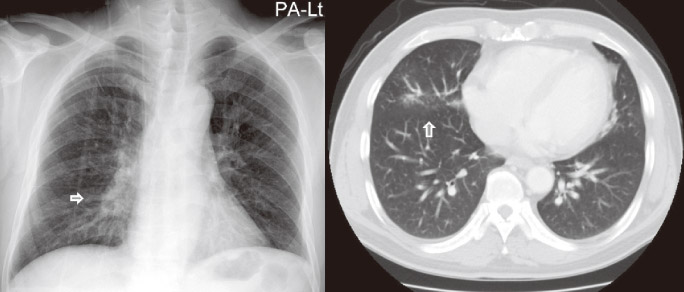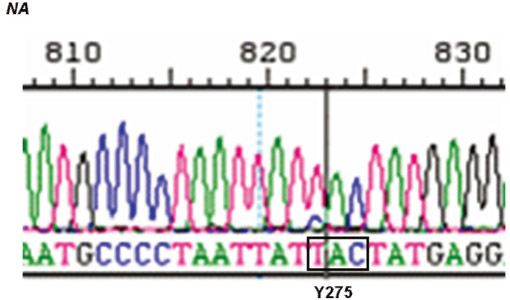Infect Chemother.
2010 Apr;42(2):107-111.
A Case of Oseltamivir-Resistant Pandemic Influenza (H1N1 2009) in a Patient with Acute Myeloid Leukemia
- Affiliations
-
- 1Department of Internal Medicine, Yonsei University Wonju College of Medicine, Wonju, Korea. hyksos@yonsei.ac.kr
- 2Department of Laboratory Medicine, Yonsei University Wonju College of Medicine, Wonju, Korea.
- 3Division of Influenza Virus, Center for Infectious Diseases, National Institute of Health, Korea Centers for Disease Control and Prevention, Seoul, Korea.
Abstract
- Oseltamivir is the drug of choice for patients with pandemic influenza (H1N1 2009). However, sporadic cases of oseltamivir resistance have been described worldwide. Up to March 2010, a total of 11 strains (2.2% of tested isolates) of oseltamivir-resistant pandemic influenza (H1N1 2009) have been discovered in South Korea. We report a case of 46-year-old man with acute myeloid leukemia in whom an oseltamivir-resistant pandemic (H1N1) 2009 virus was isolated. Despite high dose oseltamivir therapy for 10 days he had persistent symptoms and showed positive results in repeated real-time RT-PCR for pandemic influenza (H1N1 2009) virus from nasopharyngeal specimen. The patient improved eventually after oseltamivir was replaced by zanamivir inhalation.
MeSH Terms
Figure
Reference
-
1. Sullivan SJ, Jacobson RM, Dowdle WR, Poland GA. 2009 H1N1 influenza. Mayo Clin Proc. 2010. 85:64–76.
Article2. Centers for Disease Control and Prevention. Updated interim recommendations for the use of antiviral medications in the treatment and prevention of influenza for the 2009-2010 season. Accessed 8 February 2010. Available at: http://www.cdc.gov/h1n1flu/recommendations.htm.3. Moscona A. Global transmission of oseltamivir-resistant influenza. N Engl J Med. 2009. 360:953–956.
Article4. Baz M, Abed Y, Papenburg J, Bouhy X, Hamelin ME, Boivin G. Emergence of oseltamivir-resistant pandemic H1N1 virus during prophylaxis. N Engl J Med. 2009. 361:2296–2297.
Article5. Centers for Disease Control and Prevention(CDC). Oseltamivirresistant novel influenza A (H1N1) virus infection in two immunosuppressed patients - Seattle, Washington, 2009. MMWR Morb Mortal Wkly Rep. 2009. 58:893–896.6. Centers for Disease Control and Prevention(CDC). Oseltamivirresistant 2009 pandemic influenza A (H1N1) virus infection in two summer campers receiving prophylaxis - North Carolina, 2009. MMWR Morb Mortal Wkly Rep. 2009. 58:969–972.7. European Center for Disease Prevention and Control. Oseltamivir-resistant pandemic (H1N1) 2009 influenza virus, October 2009. Accessed 8 February 2010. Available at: http://www.ecdc.europa.eu/en/activities/sciadvice/Lists/ECDC%20Reviews/ECDC_DispForm.aspx?List=512ff74f-77d4-4ad8-b6d6-bf0f23083f30&ID=683.8. World Health Organization. Pandemic (H1N1) 2009 - update 95. Accessed 9 April 2010. Available at: http://www.who.int/csr/don/2010_04_09/en/index.html.9. Korea Center for Disease Control and Prevention. Influenza sentinel surveillance report (Number 13 - 2010). Accessed 11 April 2010. Available at: http://flu.cdc.go.kr.10. Deyde VM, Sheu TG, Trujillo AA, Okomo-Adhiambo M, Garten R, Klimov AI, Gubareva LV. Detection of molecular markers of drug resistance in 2009 pandemic influenza A (H1N1) viruses by pyrosequencing. Antimicrob Agents Chemother. 2010. 54:1102–1110.
Article11. Lackenby A, Democratis J, Siqueira MM, Zambon MC. Rapid quantitation of neuraminidase inhibitor drug resistance in influenza virus quasispecies. Antivir Ther. 2008. 13:809–820.
Article12. Le QM, Wertheim HF, Tran ND, van Doorn HR, Nguyen TH, Horby P. Vietnam H1N1 Investigation Team. A community cluster of oseltamivir-resistant cases of 2009 H1N1 influenza. N Engl J Med. 2010. 362:86–87.
Article13. Ison MG, Gubareva LV, Atmar RL, Treanor J, Hayden FG. Recovery of drug-resistant influenza virus from immunocompromised pat ients: a case series. J Infect Dis. 2006. 193:760–764.
Article14. Weinstock DM, Gubareva LV, Zuccotti G. Prolonged shedding of multidrug-resistant influenza A virus in an immunocompromised patient. N Engl J Med. 2003. 348:867–868.
Article15. Memoli MJ, Hrabal RJ, Hassantoufighi A, Eichelberger MC, Taubenberger JK. Rapid selection of oseltamivir- and peramivir-resistant pandemic H1N1 virus during therapy in 2 immunocompromised hosts. Clin Infect Dis. 2010. 50:1252–1255.
Article16. Kumar D, Morris MI, Kotton CN, Fischer SA, Michaels MG, Allen U, Blumberg EA, Green M, Humar A, Ison MG. AST Infectious Diseases Community of Practice and Transplant Infectious Diseases Section of TTS. Guidance on novel influenza A/H1N1 in solid organ transplant recipients. Am J Transplant. 2010. 10:18–25.
Article17. Speers DJ, Williams SH, Pinder M, Moody HR, Hurt AC, Smith DW. Oseltamivir-resistant pandemic (H1N1) 2009 influenza in a severely ill patient: the first Australian case. Med J Aust. 2010. 192:166–168.
Article18. Chan PA, Connell NT, Gabonay AM, Westley B, Larkin JM, Larosa SP, Chapin K, Mermel L. Oseltamivir resistant 2009-2010 pandemic influenza A (H1N1) in an immunocompromised patient. Clin Microbiol Infect. 2010. [Epub ahead of print].19. Center for Infectious Diseases Research and Policy. Clusters of resistant H1N1 cases reported in UK, US. Accessed 8 February 2010. Available at: http://www.cidrap.umn.edu/cidrap/content/influenza/swineflu/news/nov2009resistance.html.
- Full Text Links
- Actions
-
Cited
- CITED
-
- Close
- Share
- Similar articles
-
- A Case of Oseltamivir-Resistant Pandemic Influenza (H1N1 2009)
- The Diagnosis and Treatment of Influenza
- Acute Hemorrhagic Colitis Associated with the Use of Oseltamivir
- The Emergence of Oseltamivir-Resistant Seasonal Influenza A (H1N1) Virus in Korea During the 2008-2009 Season
- Diagnosis and Management of Novel Influenza A (H1N1)




